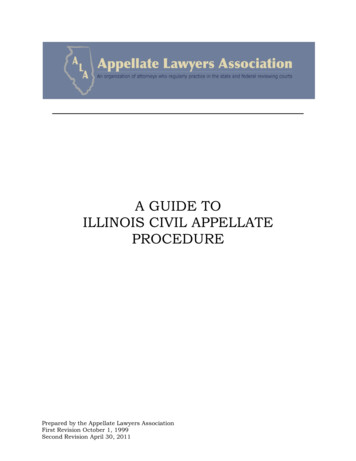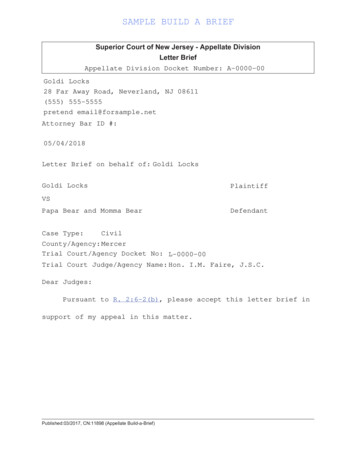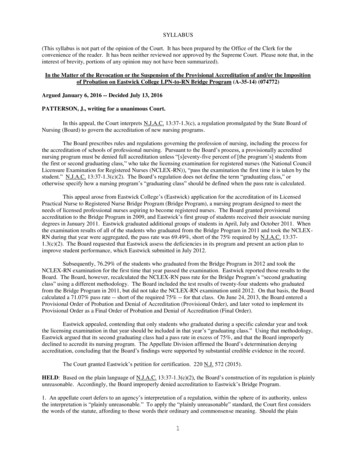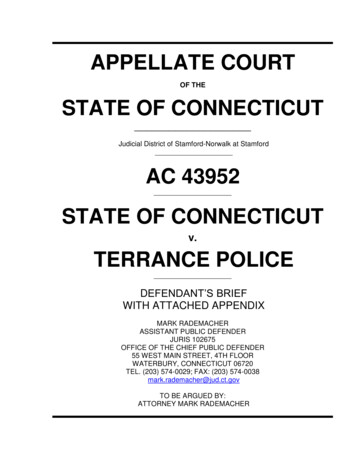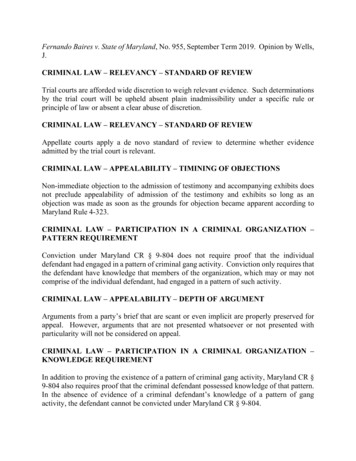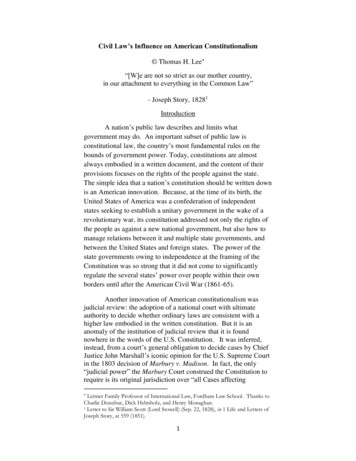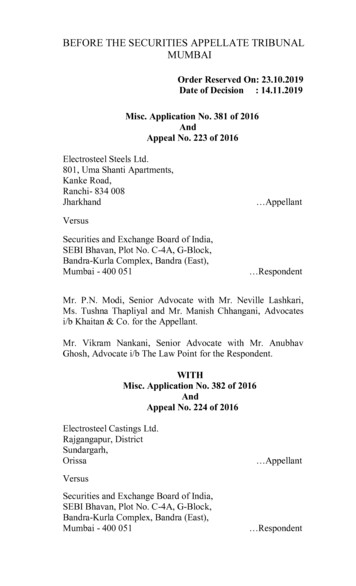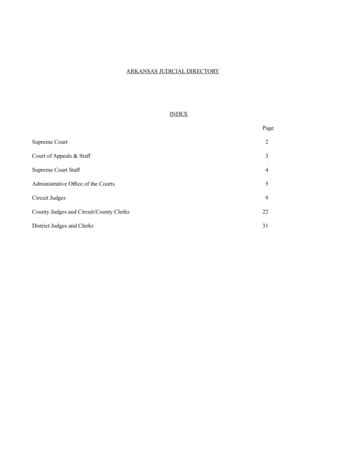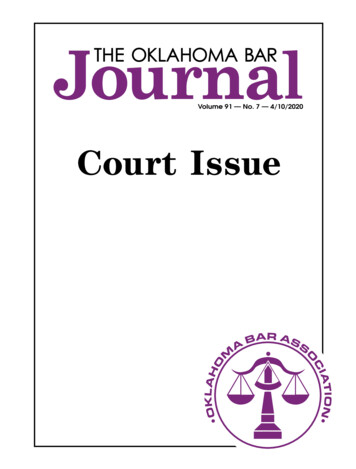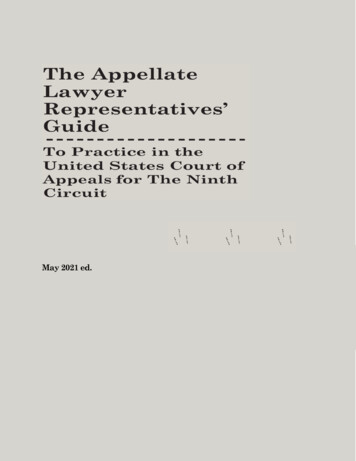
Transcription
May 2021 ed.-1 -
TABLE OF CONTENTSI.INTRODUCTION . 4II.INTRODUCTION TO THE U.S. COURT OF APPEALSFOR THE NINTH CIRCUIT . 5III.OVERVIEW OF THE APPELLATE PROCESS . 10IV.FILING AN APPEAL IN THE NINTH CIRCUIT: HOW TOGET STARTED . 20V.THE RIGHT TO COUNSEL ON APPEAL. 37VI.MEDIATION IN THE NINTH CIRCUIT . 46VII.MOTIONS PRACTICE . 54VIII.EMERGENCY PROCEEDINGS. 75IX.DRAFTING THE BRIEF . 83X.EXCERPTS OF RECORD . 105XI.ORAL ARGUMENT . 114XII.POST-DECISIONAL PROCESSES . 126XIII.REVIEW OF IMMIGRATION DECISIONS BEFORE THENINTH CIRCUIT. 147XIV.HABEAS CORPUS PROCEEDINGS . 166XV.DRAFTER’S CHECKLIST FOR APPELLATE MOTIONS . 174XVI.FILER’S CHECKLIST FOR APPELLATE MOTIONS . 177XVII.DRAFTER’S CHECKLIST FOR APPELLATE BRIEFS . 179XVIII. DRAFTER’S CHECKLIST FOR EXCERPTS OF RECORDAND SUPPLEMENTAL EXCERPTS OF RECORD . 182-2 -
XIX.COMPILER’S CHECKLIST FOR EXCERPTS OF RECORDAND SUPPLEMENTAL EXCERPTS OF RECORD . 188XX.FILER’S CHECKLIST FOR APPELLATE BRIEFS ANDEXCERPTS OF RECORD . 197XXI.RESOURCES FOR NINTH CIRCUIT PRACTICE . 200-3 -
I.INTRODUCTIONThis practice guide was developed by the Ninth Circuit AppellateLawyer Representatives as an informal guide to practice before theUnited States Court of Appeals for the Ninth Circuit. It does notrepresent the views of the judges or the employers of the appellatelawyer representatives.This guide is an evolving document, and we welcome suggestionsfor its improvement. Please email any suggestions or comments toALRPracticeGuide@ca9.uscourts.gov. We will do our best to keep theguide up to date, but rules, general orders, and electronic filing systemscan and do change. In the event of conflict, follow the rules.Finally, a special “thank you” to the representatives who draftedand commented on sections, as well as members of the Ninth CircuitClerk’s Office who commented on the guide. Those individuals includelead editor Jean-Claude André, Helen H. Hong, Dan Kaplan, CaseyPitts, Leah Spero, James Azadian, Ryan Bounds, Brian Goldman, AnneVoigts, Liora Anis, Susan Gelmis, Paul Keller, and Stephen Liacouras.-4 -
II.INTRODUCTION TO THE U.S. COURT OF APPEALS FOR THENINTH CIRCUITI.THE COURTThe U.S. Court of Appeals for the Ninth Circuit handles appealsarising from the federal trial and bankruptcy courts in the 15judicial districts within the Circuit. Judicial districts within theNinth Circuit include the districts of Alaska, Arizona, CentralCalifornia, Eastern California, Northern California, SouthernCalifornia, Hawaii, Idaho, Montana, Nevada, Oregon, EasternWashington, Western Washington, the U.S. Territory of Guam,and the Commonwealth of the Northern Mariana Islands. TheCourt also has jurisdiction over petitions for review orenforcement of orders by several agencies, such as the Board ofImmigration Appeals and the National Labor Relations Board.II.COURT STRUCTURE AND PROCEDURESA.PHYSICAL FACILITIES The Court’s headquarters islocated at 95 Seventh Street, San Francisco, California94103. The mailing address is P.O. Box 193939, SanFrancisco, California 94119-3939. The Clerk’s Office may bereached at (415) 355-8000. Divisional Clerk’s Offices arelocated in Pasadena, Seattle, and Portland. The Court alsohas three regional administrative units to assist the ChiefJudge of the Circuit with administrative responsibilities: theNorthern, Middle and Southern units. The most senioractive judge of each unit is designated the administrativejudge of the unit, and serves a non-renewable three-yearterm.1.The Northern Unit includes the districts of Alaska,Idaho, Montana, Oregon, and Eastern and WesternWashington.-5 -
2.The Middle Unit includes the districts of Arizona,Nevada, Hawaii, Guam, Northern and EasternCalifornia, and the Northern Mariana Islands.3.The Southern Unit includes the districts of Centraland Southern California.Cases arising out of the Northern Unit are generallycalendared in Seattle or Portland for oral argument; casesfrom the Middle Unit are generally heard in San Francisco;and cases from the Southern Unit are usually calendared inPasadena. Cases may be heard in places specially designatedby the Court. (For example, the Court occasionally hearscases at law schools within the Circuit.)B.JUDGES AND SUPPORTING PERSONNEL1.Judges By statute, Congress authorizes 29 activejudgeships within the Ninth Circuit. A judge maytake “senior status” after a certain combination ofyears of service and age. A judge who has takensenior status still hears and decides cases, but maycarry a reduced caseload. While a senior judgeotherwise maintains the same responsibilities as anactive judge, senior judges cannot vote on whetherto take a case en banc. There are several seniorcircuit judges who regularly hear cases. AlthoughSan Francisco is the Court’s headquarters, most ofthe active and senior judges maintain theirresidence chambers in other cities within theCircuit. The locations of the judges’ chambers arelisted on the Court’s website atwww.ca9.uscourts.gov.2.Appellate Commissioner The AppellateCommissioner role was created to serve a variety offunctions for the Court of Appeals, including rulingon a wide range of motions filed before a case is-6 -
assigned to a three-judge panel for decision on themerits, managing the compensation of appellatecounsel appointed under the Criminal Justice Act torepresent parties financially unable to retaincounsel, managing attorney disciplinary mattersand attorney’s fees in civil disputes upon referral bya panel, and conducting case managementconferences in complex, multi-party criminalappeals. In the wake of the AppellateCommissioner’s retirement at the end of 2020, theCJA compensation duties have been reassigned to anew CJA Administrative Attorney position in theClerk’s Office, and the Director of the Office of StaffAttorneys is serving as Interim AppellateCommissioner with respect to the remaining duties.3.Clerk’s Office Clerk’s Office personnel areauthorized to act on certain procedural motions, tohandle stipulations for dismissal, and to dismisscases for failure to prosecute. Inquiries concerningrules and procedures may be directed to the Clerk’sOffice. On matters requiring special handling,counsel may contact the Clerk’s Office forinformation and assistance. No judge or anymember of the Court staff will give legal advice.Court information, including Court rules, thegeneral orders, calendars, and opinions, and manyother resources for attorneys and the public areavailable on the Court’s website atwww.ca9.uscourts.gov.4.Office of Staff Attorneys Staff attorneys performa variety of tasks for the Court. They work for theentire Court, not individual judges.a.Inventory After briefing is completed, the casemanagement attorneys review the briefs andrecord and identify the primary issues raised in-7 -
the case. The case management attorneys thenassign a numerical weight to the case to reflectthe complexity of the case and the number ofissues presented. This weighting process isdesigned to distribute workload evenly among theactive judges, as described in Chapter III.b.Research For cases that are not calendared fororal argument, research attorneys review briefsand records, research legal issues, and draft nonprecedential memorandum dispositions for oralpresentation to three-judge panels. (Judges alsohire term law clerks who may assist with casesthat are calendared.)c.Motions Motions attorneys process all motionsfiled in a case before a panel is assigned, exceptfor procedural motions handled by the Clerk. Themotions unit attorneys also process emergencymotions filed pursuant to Ninth Circuit Rules 273 and 27-4, and motions for reconsideration oforders filed by motions panels.5.Circuit Court Mediators Circuit Court Mediatorsare permanent members of the Court staff. They areexperienced appellate practitioners who have hadextensive mediation and negotiation training.Shortly after a new civil case is docketed, the CircuitCourt Mediators review the MediationQuestionnaire to evaluate whether a case appearssuitable for the Court’s settlement program. SeeNinth Cir. R. 3-4 and 15-2. The Court’s mediationprogram is discussed in detail in Chapter VI.6.Library The Ninth Circuit library system, headedby the Circuit Librarian, consists of 21 staffedlibraries, including the headquarters library in SanFrancisco and 20 branch libraries located-8 -
throughout the Circuit. Court libraries may maketheir collections available to members of the bar andthe general public depending on local court rules.7.C.Circuit Executive’s Office The Circuit Executive’soffice is the arm of the Circuit’s Judicial Councilthat provides administrative support to appellate,district court, magistrate, and bankruptcy judges inthe Circuit.THE JUDICIAL COUNCIL The Judicial Council,established pursuant to 28 U.S.C. § 332, is currentlycomposed of the Chief Judge, four circuit judges, and fourdistrict court judges. The Council convenes regularly toconsider and take action upon any matter affecting theadministration of its own work, as well as that of all federalcourts within the Circuit, including some judicial misconductcomplaints.-9 -
III.OVERVIEW OF THE APPELLATE PROCESSI.THE LIFESPAN OF A CASE IN THE NINTH CIRCUIT- 10 -
II.COURT PROCEDURES FOR PROCESSING AND HEARINGCASESA.HOW DOES THE COURT DETERMINE HOW A CASEWILL BE HANDLED? After briefing is completed, casemanagement attorneys inventory cases to assign the case anumerical weighting by type, issue, and complexity. Thisprocess enables the Court to balance judges’ workloads andhear unrelated appeals involving similar legal issues at asingle sitting. There are four main routes to a decision by theCourt: (1) by a three-judge panel, after briefing and oralargument; (2) by a three-judge panel, after briefing andcalendaring, but without oral argument; (3) by an oral orwritten screening panel, to whom staff attorneys havepresented the case after briefing; and (4) through motions- 11 -
practice. The majority of cases are decided without oralargument.B.WHAT HAPPENS WITH CASES ASSIGNED TO ASCREENING PANEL?1.How are cases assigned to screeningcalendars? Screening cases must: (1) be eligible forsubmission without oral argument under FRAP34(a); and (2) meet both of the following criteria: (a)the result is clear and (b) the applicable law isestablished in the Ninth Circuit based on Circuit orSupreme Court precedent.2.What happens after my case is assigned to ascreening calendar? After the Clerk assigns acase to the screening calendar, the Clerk’s Officeforwards the case materials to the staff attorneys.The staff attorneys then place each screening caseon either an oral screening calendar or a writtenscreening calendar.a.Oral Screening Panel Presentationsi.What happens before the panel? Once acase is placed on an oral screening calendar,staff attorneys prepare proposeddispositions of the case, referred to as“memorandum dispositions.” An authoringjudge is designated for each case presentedto the oral screening panel, and the writingassignment rotates among the three panelmembers.ii.What happens during the panel? Thestaff attorneys orally present the proposeddispositions to the screening panels atperiodically scheduled sessions. After the- 12 -
staff attorneys present each case, the panelmembers discuss the proposed dispositionand make any necessary revisions. If thethree panel members unanimously agreewith the disposition, the designatedauthoring judge directs the presentingattorney to certify the proposed dispositionfor filing pursuant to General Order 6.9.iii.b.What happens after the panel? Casespresented at the oral screening panel areordinarily decided by unpublishedmemorandum or order. If, in the judgmentof the panel, a decision warrantspublication, the resulting order or opinion isincluded in the Court’s internal daily prepublication report and specifically flaggedas a decision arising from a motions orscreening panel.Written Screening Panelsi.How are cases assigned to the writtenscreening panel? When a writtenscreening panel indicates that it is ready forcase assignments (identifying the number ofcases that it is prepared to take), Court staffsends the panel the requested number ofcases from a pool of cases designated forscreening. The panel identifies for theClerk’s Office the judge who will have thewriting assignment. The authoring judgeprepares and circulates an optional benchmemorandum and a proposed dispositionfor comment and approval.- 13 -
ii.C.How does the written screening paneldispose of cases? Like dispositions fromoral screening panels, cases sent to awritten screening panel are ordinarilydecided by unpublished memoranda. If thepanel has not issued a separate ordersubmitting the case, a footnote in thedisposition indicates that the panelunanimously agrees that the case should besubmitted on the briefs pursuant to FederalRule of Appellate Procedure 34(a).3.Can a case be reassigned from screening? Yes.All three judges must agree that the case is suitablefor the screening program before a case is disposedof by a screening panel. Any one judge may reject acase from screening if it does not meet the screeningcriteria, as outlined above. If a case is rejected fromscreening, it is typically scheduled for the nextavailable argument calendar.4.What can I do if my case was adverselydecided by a screening panel? You may file apetition for rehearing and/or rehearing en banc. TheClerk forwards the petition to the staff attorney whopresented the case to the oral screening panel. Thatstaff attorney then forwards to the panel: (1) a copyof the petition for rehearing and/or rehearing enbanc; and (2) a memorandum discussing the issuesraised in the petition for rehearing and/or rehearingen banc.WHAT HAPPENS WITH CASES SCHEDULED FORORAL ARGUMENT?1.How are Court calendars designated? The Clerksets the time and place of court calendars at leastsix months in advance, taking into account the- 14 -
availability of judges, the number of cases to becalendared, and the hearing location required bystatute or policy. Judges are randomly assigned bycomputer to particular days or weeks on thecalendars to equalize the workload among thejudges. At the time judges are assigned to panels,the Clerk does not know which cases will beallocated to each of the panels.2.How are cases allocated to a specific calendar?Direct criminal appeals receive preference pursuantto Federal Rule of Appellate Procedure 45(b)(2) andare placed on the first available calendar afterbriefing is completed. Other cases get priorityhearing dates by statute or rule, such asapplications for temporary or permanentinjunctions, recalcitrant witness appeals, certainhabeas corpus appeals, and appeals allegingdeprivation of medical care to an incarceratedperson. See Ninth Cir. R. 34-3. A case’s designationon the Court’s calendar is a function of both thestatutory priority and the length of time it has beenpending. Pursuant to Federal Rule of AppellateProcedure 2, the Court in its discretion may orderthat any individual case receive expeditedtreatment.3.Are all cases randomly assigned? Nearly allcases are randomly assigned. However, a case heardby the Court on a prior appeal may be set before thesame panel upon a later appeal, and capital caseswill be set before the same panel upon a laterappeal. Ninth Cir. R. 22-2(c). (If the panel thatoriginally heard the matter does not specify itsintent to retain jurisdiction over any further appeal,either party may file a motion to have the caseheard by the original panel.) A matter on remandfrom the United States Supreme Court is also- 15 -
referred to the panel that previously heard thematter. The Court occasionally groups togethercases with similar issues so that they can beconsidered by the same panel, and, as withindividual cases, these clusters of cases arerandomly assigned to a panel.4.Where are Court calendars held? The Courtposts the specific locations and dates of its sessionsheld in the current year and scheduled for thefollowing year on its website, which can be accessedthrough this link:https://www.ca9.uscourts.gov/court sessions/.Usually, court calendars, consisting of one week ofmultiple sittings, are held throughout the year inthe following places: D.Monthly in San Francisco (usually the secondweek of each month but sometimes two weeks)Monthly in Pasadena (usually the first week ofeach month but sometimes two weeks)10 times annually in Seattle (usually the firstweek of each month)6 times in Portland3 times in Honolulu2 times in Anchorage andOn an ad hoc basis, in other federal courthousesthroughout the Circuit such as Phoenix, LasVegas, or law schools.SELECTION OF PANELS The Clerk sets the time andplace of the calendars. The Clerk uses a matrix composed ofall active judges and senior judges who have indicated theiravailability. The aim is to enable each active judge to sitwith every other active and senior judge approximately thesame number of times and to assign active judges an equalnumber of times to each of the locations at which the Courtholds hearings. At present, all panels are composed of no- 16 -
fewer than two members of the Court, at least one of whomis an active judge. Every year, each active judge, except theChief Judge, is expected to sit on 32 days of oral argumentcalendars; one oral screening panel; one motions panel; andone Certificate of Appealability panel. Senior judges maydecide how many cases they want to hear.1.E.Why is there a judge on my panel who is not aNinth Circuit judge? The Court on occasion callsupon district judges and judges from other circuitsto sit on panels when there are not enough NinthCircuit judges to constitute a panel. Under Courtpolicy, district judges do not participate in appealsfrom their own districts.WHAT HAPPENS AFTER MY CASE HAS BEENASSIGNED TO A PANEL? After the cases have beenassigned to the panels, the briefs and excerpts of record ineach case are distributed to each of the judges scheduled tohear the case. The documents are usually received in thejudges’ chambers twelve weeks prior to the scheduled datefor hearing, and it is the policy of the Court that each judgeread all of the briefs prior to oral argument.1.ORAL ARGUMENT Roughly sixteen weeks beforea calendar, the Court will send a pre-calendaringnotice to the parties that a case is being considered fororal argument during that particular calendar. Theparties have 3 days from receiving the notice tonotify the Court of any conflicts with those dates.The Clerk subsequently sends a hearing notice to allcounsel of record approximately ten weeks prior tothe date of oral argument. The hearing noticeadvises of the location and date of the argument andthe amount of time allotted for argument, but doesnot identify the judges on the panel.- 17 -
F.a.How long does it take from the time of thenotice of appeal until oral argument? Fornon-priority civil, agency, or bankruptcy appeals,cases are typically scheduled for oral argument12-18 months from the notice of appeal date. Ifbriefing is not extended or delayed, this isgenerally 6-10 months from completion ofbriefing. For criminal appeals, cases are typicallyscheduled for oral argument 4-5 months afterbriefing is complete.b.When are the identities of the judges on apanel disclosed? The names of the judges oneach panel are released to the parties and generalpublic on the Monday of the week precedingargument. The panel members are listed on theoral argument calendar on the Court’s website athttps://www.ca9.uscourts.gov/calendar/.c.Will my case actually get oral argument?Merits panels often decide appeals “on the briefs”(meaning without oral argument) even after theyare placed on an argument calendar. If the paneldetermines that oral argument is unlikely toenhance their review and decision-making, thepanel will notify the parties of this determinationas soon as possible after the case is calendared.However, cases may in rare instances besubmitted without oral argument as late as theday of argument.WHAT HAPPENS AFTER ORAL ARGUMENT? At theconclusion of each day’s argument session, the judges oneach panel confer on the cases they have heard. Each judgeexpresses his or her tentative views, and the judges vote inreverse order of seniority. The judges reach a tentativedecision regarding the disposition of each case and whetherit should be in the form of a published opinion or- 18 -
unpublished memorandum. The presiding judge thenassigns each case to a judge for the preparation andsubmission of a disposition.G.HOW LONG DOES IT TAKE FROM THE TIME OFARGUMENT TO THE TIME OF DECISION? The Courthas no time limit, but most cases are decided within 3months to a year.H.CAN I SEEK REHEARING? Yes, you may petition theCourt for a rehearing of your case by the panel that decidedit or a rehearing by the Court en banc. The process for doingso is discussed in Chapter XII of this guide (Post-DecisionalProcesses).I.HOW LONG DOES IT TAKE TO DECIDE A PETITIONFOR PANEL REHEARING OR PETITION FORREHEARING EN BANC? The Court has no time limit. Adecision on a petition for rehearing en banc may take a fewmonths.J.IS THERE A PROCESS FOR SPECIAL MANAGEMENTOF COMPLEX CASES? Yes, a party may request, or theCourt may order sua sponte, special management forcomplex appeals. If special management is ordered, Courtstaff will schedule a case management conference to managethe appeal effectively and develop a briefing plan. However,case management conferences are held only in exceptionalcircumstances, such as complex cases involving numerousseparately represented litigants or extensive district court oragency proceedings.- 19 -
IV.FILING AN APPEAL IN THE NINTH CIRCUIT: HOWTO GET STARTEDI.FILING A NOTICE OF APPEALA.WHY FILE? Filing a timely Notice of Appeal is thenecessary first step to initiating an appeal in the NinthCircuit. In essence, the filing of a notice of appeal divests thedistrict court of jurisdiction over the appealed matter andtransfers jurisdiction to the Ninth Circuit. Filing a notice ofappeal is the appropriate method for initiating a directappeal in the Ninth Circuit. The notice of appeal is theproper vehicle for appealing final judgments and certaininterlocutory or collateral orders. The deadlines for filingare discussed below.1.What is a final judgment? A final judgment is onethat “ends the litigation on the merits and leavesnothing for the court to do but execute the judgment.”Catlin v. United States, 324 U.S. 229, 233 (1945). As ageneral matter, the following orders are final, and thusshould be appealed via the filing of a Notice of Appeal: Orders dismissing a complaint without leave toamend;Orders granting summary judgment as to allclaims; andJudgments imposing a sentence in a criminalcase.- 20 -
B.2.Which interlocutory orders are appealable?Rulings that decide some issue(s) in the case, but notthe whole case, are “interlocutory orders.” Certaininterlocutory orders, though not final, may also beappealed by filing a Notice of Appeal. The most commonexample is an order granting or denying a motion forinjunctive relief. Whether the motion seeks preliminaryor permanent relief, the non-prevailing party may bringa direct appeal of the district court’s order pursuant to28 U.S.C. § 1292(a)(1). Other examples include certaininterlocutory orders in admiralty cases (28 U.S.C.§ 1292(a)(3)), and certain interlocutory orders involvingarbitration proceedings (9 U.S.C. § 16).3.What is an appealable collateral order? Thecollateral order doctrine allows appeals frominterlocutory rulings (preceding final judgment) so longas those rulings conclusively decide an issue separatefrom the merits of the case and would be effectivelyunreviewable after final judgment. Cohen v. BeneficialIndus. Loan Corp., 337 U.S. 541, 546 (1949). Suchrulings are deemed “final” within the meaning of 28U.S.C. § 1291. A common example of an immediatelyappealable collateral order in the Ninth Circuit is adistrict court’s ruling on a motion to strike broughtunder California’s anti-SLAPP statute, California Codeof Civil Procedure § 425.16. See, e.g., DC Comics v. Pac.Pictures Corp., 706 F.3d 1009, 1011 (9th Cir. 2013).HOW TO FILE1.The Notice of Appeal Parties must file their Noticeof Appeal with the district court, not the Ninth Circuit.A form Notice of Appeal (“Form 1”) can be downloadedfrom the Ninth Circuit’s website:https://www.ca9.uscourts.gov/forms/. Pursuant toFederal Rule of Appellate Procedure 3(c), the Notice of- 21 -
Appeal must contain the following information: The party or parties taking the appeal;The judgment, order, or part thereof beingappealed; andThe name of the court to which the appeal istaken (i.e., the “United States Court of Appealsfor the Ninth Circuit”).In addition, the Notice of Appeal must be signed by theappealing party or the party’s attorney. See McKinneyv. De Bord, 507 F.2d 501, 503 (9th Cir. 1974). Form 1has a fill-in field for an electronic signature at the verybottom of the page.2.Filing Fee Parties in civil cases must also pay thefiling fee to the district court, unless they havepreviously been allowed to proceed in forma pauperis.3.Representation Statement In a civil case, arepresented party filing a Notice of Appeal mustcontemporaneously file a Representation Statement,which identifies the parties and includes the names,addresses, and telephone numbers of the parties’respective counsel. You have the option of using NinthCircuit Form 6 for your Representation Statement, byattaching that completed form to your Notice of Appealfor filing in the district court. Self-representedlitigants and counsel in other (non-civil) cases areencouraged to file a Representation Statement, butthey are not required to do so. Be sure to follow thehelpful instructions that accompany Form 6.https://www.ca9.uscourts.gov/forms/. It is critical thatyou review the counsel and party listing for the newappeal to ensure that it accurately lists the parties andtheir counsel.- 22 -
4.Mediation Questionnaire After the appellant files aNotice of Appeal in a civil case, the Clerk of the Courtwill distribute a Mediation Questionnaire (along withthe Court’s scheduling order). Within seven days aftera counseled civil appeal is docketed, the appellant mustand the appellee may complete and submit the NinthCircuit Mediation Questionnaire (Form 7 available forms/form07.pdf). The Mediation Questionnaire is a publicdocument that will appear on the Court’s docket. Onceit is submitted for filing, the parties will receive a linkto a webform they can use to submit additional,confidential information directly to the CircuitMediators. In the past, civil appellants were requiredto file a Docketing Statement, which required a briefstatement of the issues to be raised on appeal. Becausethe Mediation Questionnaire has superseded theDocketing Statement, appellants no longer need to filea Docketing Statement.5.Petitions for Review in Agency Cases The processfor reviewing an agency order in the Ninth Circuit isinitiated by filing a Petition for Review, rather than aNotice of Appeal. A form Petition for Review isavailable on the Court’s oads/forms/form03.pdf.- 23 -
C.WHEN TO FILE1.30-Day Deadline in Civil Case In a civil case, theNotice of Appeal must be filed within 30 days of entryof the appealed judgment or order. Fed. R. App. P.4(a)(1)(A). However, when one of the parties is theUnited States, a United States agency, or a UnitedStates officer or employee sued in an official capacity orin an individual capacity for an act or omissionoccurring in connection with duties performed on theUnited States’ behalf, the time to appeal is 60 days.Fed. R. App. P. 4(a)(1)(B).2.14-Day Deadline for Defendants in CriminalCases In a criminal case, the defendant must file aNotice of Appeal within 14 days of entry of theappealed judgment or order. Fed. R. App. P. 4(b)(1)(A).When the government is entitled to appeal, its Noticeof Appeal must be filed within 30 days. Fed. R. App. P.4(b)(1)(B). If the government files an appeal, thedefendant has 14 days from the filing of thegovernment’s Notice of Appeal, or the time otherwiseprescribed under Federal Rule of Appellate Procedure4(a), whichever ends later, to file a notice of crossappeal. In criminal cases, the deadline to appeal is notjurisdictional but is a claim-processing rule subject to- 24 -
forfeiture. United States v. Sadler, 480 F.3d 932, 94142 (9th Cir. 2007).3.Varied Deadlines in Agency Cases The time limitfor filing a Petition for Review varies by agency andwill depend on the terms of the statute authorizingjudicial review. Typical deadlines range from 30 to 60days, but vary significantly depending on the statute.One of the most common deadlines is the 30-daydeadline to appeal a final order of removal inimmigration cases (8 U.S.C. § 1252(b)(1)). As in civilcases, the deadline for filing a Petition for Review isjurisdictional, and an untimely Petition will bedismissed.D.CROSS-APPEALS If one party timely files a Notice ofAppeal, any other party can file its own Notice of Appealwithin 14 days of
Shortly after a new civil case is docketed, the Circuit Court Mediators review the Mediation Questionnaire to evaluate whether a case appears suitable for the Court's settlement program. See . Ninth Cir. R. 3-4 and 15-2. The Court's mediation program is discussed in detail in Chapter VI. 6. Library. The Ninth Circuit library system, headed
